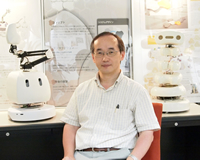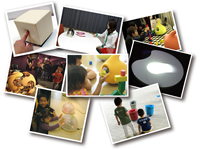Feature
Learning how to socialize with robots
Robot communications with humans is little better than that of speaking vending machines saying, “thank you,” after a purchase, argues Professor Michio Okada. “You just don’t feel any real communication is going on, because there is no social coupling taking place.” To understand this phenomenon better and to improve robot-to-human communications, Okada has established the Interaction and Communications Design Laboratory (ICD-lab) in Toyohashi Tech.
ICD-lab is a multidisciplinary laboratory that employs electronics, mechanical design, software, sensors and so on, together with Okada’s own research in computer engineering and cognitive science, to build novel “social robots and devices,” often of a minimalistic design for specific research purposes. To the unsuspecting visitor it might appear that the idea is merely to develop entertaining robots that engage smoothly with humans.
“But the underlying aim is to uncover the basic mechanisms of our every day communications by studying how we interact with these social robots and devices,” Okada points out.
One such research effort involves a “sociable trash box.” This is a motorized trash box fitted with electronics and a servomotor that enables it to detect trash, then locate humans and gesture to them it wants them to put the nearby trash into its trash box.
“The main purpose of these robots is to investigate the social clues and behaviors that build a social rapport and induce the assistance of children in collecting the trash,” says Okada. Findings so far include the importance of movement, especially having the robots move towards the trash to elicit assistance. Also noted is how several robots moving together, compared with just a single robot, attracts more children and causes them to establish different distances and interaction times with the robots, compared to that of a single robot.
Other ICD-lab projects include a “sociable PC” that acts as a companion through its verbal and non-verbal actions such as cute motions based on the behavioral feedback of the user, and a “sociable dining table” that employs proto-communication, i.e. the user knocking on the table, to cause robot devices on the table to move in certain directions.
Not only can this kind of research lead to better human-robot interfaces and interaction, but it is helping Okada understand the communication problems of autistic children. “Children with autism generally avoid people,” he says. “But they are interested in mechanical toys. Our social robots can become intermediaries between us and these children.”

Professor Michio Okada

Examples of socializing-robots conceived by Michio Okada.


